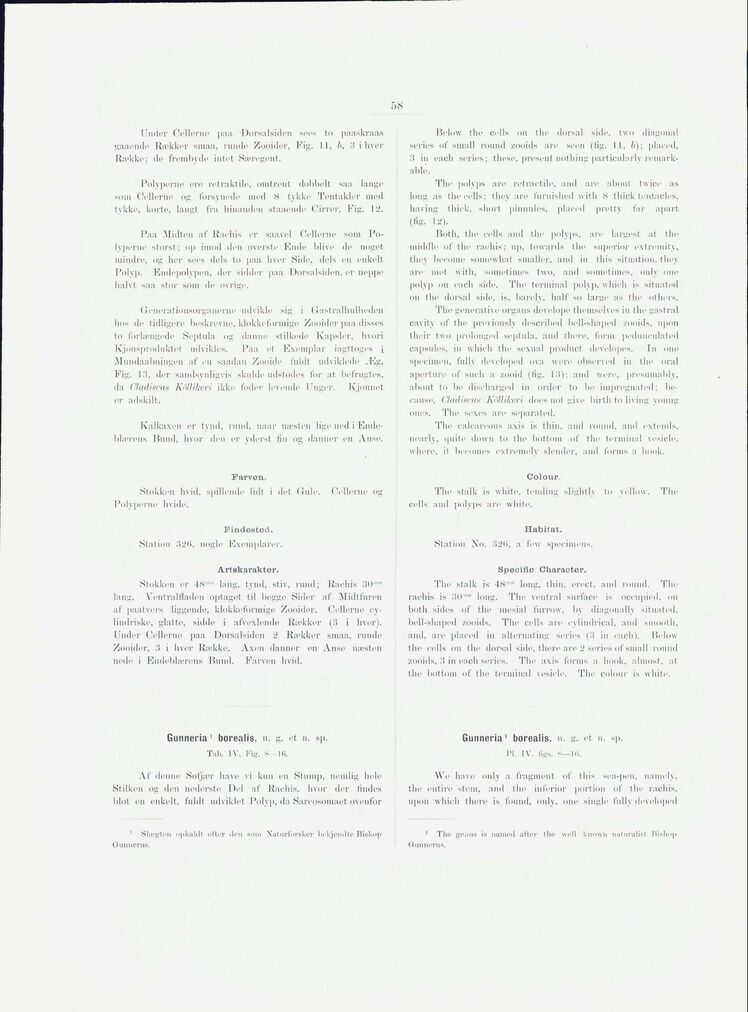
Full resolution (JPEG) - On this page / på denna sida - Sidor ...

<< prev. page << föreg. sida << >> nästa sida >> next page >>
Below is the raw OCR text
from the above scanned image.
Do you see an error? Proofread the page now!
Här nedan syns maskintolkade texten från faksimilbilden ovan.
Ser du något fel? Korrekturläs sidan nu!
This page has never been proofread. / Denna sida har aldrig korrekturlästs.
lindet* Olierne paa Dorsalsiilen sees to paaskraas
gaaende Hækker smaa. runde Zooider, Fig. 11, b. 3 i hver
Række; de frembyde intet Særegent.
Polyperne ere retraktile, omtrent dobbelt saa lange
som Cellerne og forsynede med S tykke Tentakler med
tykke, korte, langt fra hinanden staaende dirrer, Fig. 13.
Paa Midten af Rachis er saavel Cellerne som
Polyperne storst; op imod dell overste Ende blive de noget
mindre, og her sees dels to paa liver Side, dels en enkelt
Polyp. End,.polypen, der sidder paa Dorsalsiilen. er neppe
halvt saa stor som de øvrige.
Gcneratioiisorgancriie udvikle sig i Gastralhulhedeii
hos de tidligere beskrevne, klokkcføriiiige Zooider paa disses
to forlængede Septula og danne stilkede Kapsler, hvori
Kjonsproduktet udvikles. Paa et Exemplar iagttoges i
Mundaahiungoi! af en saadan Zooide fuldt udviklede Æg,
Fig. 13, der sandsynligvis skulde udstødes for at befrugtes,
da Cladisms Kmikeri ikke foder levende l;ngel’. Kjonllet
er adskilt.
Kalkaxen er tynd. rund. naar næsten lige ned i
Ende-blærens Bund, hvor dell er yderst fin og danner ell Anse.
Farven.
Stokken hvid. spillende lidt i det Gule. Cellerne og
Polyperne hvide.
Pindested.
Station 32li. nogle Exemplarer.
Artskarakter.
Stokken ei’ 4H...... lang. tynd, stiv, rund; Rachis 3(1......
lang. VeiitraMadcu optaget til begge Sider af Midtfuren
af past vers liggende, klokkeformige Zooider. Cellerne
cylindriske. glatte, sidde i afvexlende Rækker (3 i hver).
Under Cellerne paa Dorsalsiilen 2 Rækker smaa, runde
Zooider, 3 i hver Række. Axen danner ell Anse næsten
nede i Endeblærens Bund. Farven hvid.
Gunneria 1 borealis, il. g. et n. sp.
Tab.’IV, Fig, s—I«.
Af denne Soljær have vi kun en Stump, nemlig hele
Stilken og den nederste Del af Rachis. hvor der findes
blot, ell enkelt, fuldt udviklet Polyp, da Sai’eosolliaet ovenfor
’ Slægt™ opkaldt efter den will Naturforsker bekjendte Biskop
Below the cells on the dorsal sid... two diagonal
series of small round zooids are seen (lig. II, b); placed,
3 in each series; these, present nothing particularly
remarkable.
The polyps are retractile, and are about twice as
long as the cells; they are furnished with K thick tentacles,
having thick, short pinnules, placed pretty far apart
(fig. 12).
Both, the cells and the polyps, are largest at the
middle of tile raeliis; up, towards the superior extremity,
they become somewhat smaller, and in this situation, they
are met with, sometimes two, and sometimes, only one
polyp on each side. The terminal polyp, which is situated
oil the dorsal side, is, barely, half so large as the others.
The generative organs develope themselves in the gastral
cavity of the previously described bell-shaped zooids. upon
their two prolonged septula, and there, form pedunculated
capsules, in which the sexual product developes. In one
specimen, fully developed ova were observed in the oral
aperture of such a, zooid (fig. 13); and were, presumably,
about to be discharged in order to be impregnated;
because. Cladwrv:: KdUikeri does not give birth to living young
ones. The sexes are separated.
The calcareous axis is thin, and round, and extends,
nearly, quite down to the bottom of the terminal vesicle,
where, it becomes extremely slender, and forms a hook.
Colour,
The stalk is white, tending slightly lo yellow. The
cells and polyps are white.
Habitat.
Station No. 321). a few specimens.
Specific Character.
The stalk is 48™ long, thin, erect, and round. The
rachis is 30"" long. The ventral surface is occupied, ou
both sides of the mesial furrow, by diagonally situated,
bell-shaped zooids. Tile cells are cylindrical, and smooth,
and. are placed in alternating series (3 in each). Below
the cells 011 the dorsal side, there are 2 series of small round
zooids. 3 in each series. The axis forms a, hook, almost, at
the bottom of the terminal vesicle. The colour is white.
Gunneria1 borealis, il. g. et n. sp.
pt. IV. tig«, s—in.
We have only a fragment of this sea-pen, namely,
the entire stem, and the inferior portion of tile rachis.
upon which there is found, only, one single fully developed
1 The g«.His is named after the well known naturalist Bishop
<< prev. page << föreg. sida << >> nästa sida >> next page >>